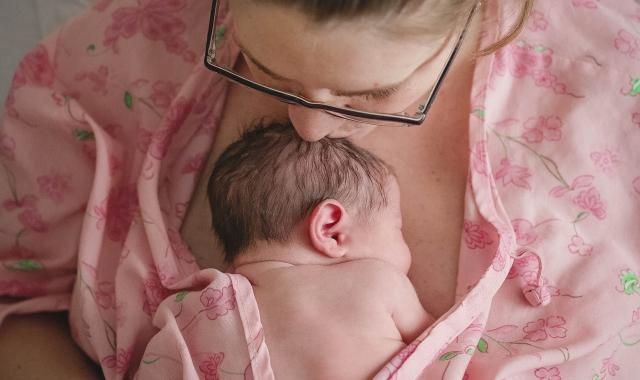It's safer to breastfeed than formula-feed your baby if you smoke.

Worried that smoking or vaping means you shouldn’t breastfeed? Many mums think formula is safer because nicotine from cigarettes or vapes can pass into breastmilk. While this is true, breastfeeding is still safer than formula for mums who smoke or vape. Here’s why.
Babies exposed to second-hand smoke or vapour have a higher risk of chest infections, asthma and sudden infant death syndrome (SIDS).1 Breastmilk contains important factors that help babies fight these illnesses so breastfeeding helps protect your baby from the harmful effects of cigarette smoke.2,3
If you’re pregnant, breastfeeding, or caring for a young baby, it’s best not to smoke. But if you can’t stop or cut down, then it’s better to smoke and breastfeed than smoke and formula feed.4
Some women vape to help them quit smoking, or because they believe it’s safer for their baby than cigarettes. There isn’t enough research yet to know if this is true. Vapes (e-cigarettes) can be harmful. They contain nicotine, even when labelled ‘nicotine-free’, and many other chemicals. These can pass into breastmilk and affect your baby’s health.5
If you smoke or vape
There are ways to breastfeed so your baby gets less nicotine from your milk. The following tips apply to vaping as well as smoking.
Breastfeed first, then smoke
Nicotine levels in your breastmilk drop over time after you smoke. About 1½ hours after a cigarette, the amount of nicotine in your milk is about half what it was right after smoking.6,7 The longer you wait, the less nicotine your baby will get from your milk.
Other tips to reduce harm for your baby
- Keep your home and car smoke-free. Don’t let anyone smoke near your baby.
- Never smoke where your baby sleeps and don’t sleep on the same surface as your baby.8
- Cover up and clean up. Chemicals stick to your clothes, hair, and skin so do what you can to reduce this. For example, change your outer clothes, wash your face and hands and brush your teeth before you hold your baby.
Thinking about quitting?
Quitting smoking at any time during pregnancy or breastfeeding will give your baby a healthier start in life.
There are different ways to help you quit. Visit www.quitnow.gov.au or talk to your doctor. Let them know you’re breastfeeding so they can help you choose the safest option.
- Some people use nicotine patches. If you use low milligram (ie 7 mg or 14 mg instead of 21 mg) nicotine patches and don’t smoke, you’ll have less nicotine in your breastmilk.9 Don’t smoke any cigarettes at the same time as using a nicotine patch and follow the guidelines for that product.
- If you are using nicotine gum, breastfeed first then chew the gum after so there is less nicotine in your breast milk.
- If you’re thinking about using a vape to quit smoking, you’ll need to talk to your doctor or pharmacist first. Vapes are not risk-free and are not recommended as the first option for quitting.10 You’ll need a prescription from your doctor to use nicotine vapes to help quit.
- Australian Government Department of Health. (2024). Children and smoking, vaping and tobacco. Retrieved from https://www.health.gov.au/topics/smoking-vaping-and-tobacco/audiences/c…
- Hauck, F. R., Thompson, J. M., Tanabe, K. O., Moon, R. Y. & Vennemann, M. M. (2011). Breastfeeding and reduced risk of sudden infant death syndrome: A meta-analysis. Pediatrics, 128(1), 103–110. https://doi.org/10.1542/peds.2010-3000
- Ip, S., Chung, M., Raman, G., Chew, P., Magula, N., DeVine, D., Trikalinos, T., & Lau, J. (2007). Breastfeeding and maternal and infant health outcomes in developed countries. Evidence Reports/Technology Assessments, 153, 1–186. https://www.ncbi.nlm.nih.gov/books/NBK38337/
- Dorea J. G. (2007). Maternal smoking and infant feeding: Breastfeeding is better and safer. Maternal and Child Health Journal, 11(3), 287–291. https://doi.org/10.1007/s10995-006-0172-1
- NHMRC CEO Statement Summary on Electronic Cigarettes. https://www.nhmrc.gov.au/health-advice/all-topics/electronic-cigarettes…
- Dahlström, A., Ebersjö, C., & Lundell, B. (2004). Nicotine exposure in breastfed infants. Acta Paediatrica, 93(6), 810–816. https://doi.org/10.1111/j.1651-2227.2004.tb03023.x
- Luck, W. & Nau, H. (1984). Nicotine and cotinine concentrations in serum and milk of nursing smokers. British Journal of Clinical Pharmacology, 18(1), 9–15. https://doi.org/10.1111/j.1365-2125.1984.tb05014.x
- Red Nose Australia. (2024). Safe Sleeping. Retrieved from https://rednose.org.au/resources/safe-sleeping/
- Ilett, K. F., Hale, T. W., Page-Sharp, M., Kristensen, J. H., Kohan, R. & Hackett, L. P. (2003). Use of nicotine patches in breast-feeding mothers: Transfer of nicotine and cotinine into human milk. Clinical Pharmacology and Therapeutics, 74(6), 516–524. https://doi.org/10.1016/j.clpt.2003.08.003
- Australian Government Department of Health. (2024). Vapes: information for individuals and patients. Therapeutic Goods Administration. https://www.tga.gov.au/products/unapproved-therapeutic-goods/vaping-hub/vapes-information-individuals-and-patients
The information on this website does not replace advice from your health care providers.
© Australian Breastfeeding Association January 2026